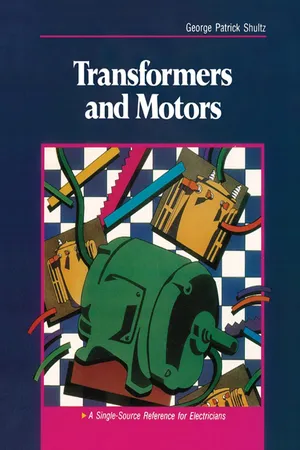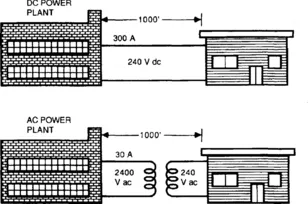![]()
PART I
TRANSFORMERS
![]()
Introduction to Transformers
1. Fundamental Concepts: Transformers
2. Transformer Connections
3. Installation
4. Maintenance, Troubleshooting, and Repair
5. Distribution Systems
![]()
CHAPTER 1
Fundamental Concepts: Transformers
When power generation was introduced in this country through the efforts of Thomas Edison, the first plants were all direct current (DC) generation facilities. This meant that each power plant had to be close to the consumers because of the inherent losses of DC transmission of power. Efforts to use alternating current (AC) proved to be futile due to hysteresis and eddy current losses. Even with the introduction of AC transmission, many DC plants were still in use in the mid 1900s.
Primarily through the genius of one man, Charles Proteus Steinmetz (1865–1923), the theory of AC transmission was perfected, and the use of AC made possible. Dr. Steinmetz was a physically handicapped refugee from Germany who was almost refused entry into the United States because of his deformity and poverty. His report in 1892 on hysteresis losses gained him an invitation to join a little-known corporation called the General Electric Company (GE). His work at GE is one of the chief contributing factors in the success of that organization and was primary to the company becoming one of the principal manufacturers of transformers and AC motors.
A transformer is an electromagnetic device that transfers electrical energy from one circuit to another through mutual inductance. It is one of the most remarkable devices ever conceived. In most cases, it performs its assigned task without supervision year after year and with very little maintenance. It allows the power company to economically supply a single source voltage over a long distance to the customer, where other transformers change the value of the source voltage to the voltages required by the multitude of electrical and electronic devices utilized in the home, office, farm, and industrial plant. Transformers are the single most important apparatus that makes possible our modern electrical distribution system.
Comparing Direct Current to Alternating Current
To illustrate this point, let’s assume a power plant is 1000 feet from the user whose equipment requires 300 amperes at 240 volts. For discussion, the current density on the transmission lines will be the same. The DC power plant must supply 300 amperes at 240 volts over the wires. The AC power plant can supply 30 amperes at 2400 volts and deliver the same amount of power to the customer, where it can be transformed to 240 volts, 300 amperes. Figure 1-1 illustrates the two situations.
FIGURE 1-1 Comparison of DC and AC power transmission.
In order to have the same current density on both transmission lines, based on the American Standard Wire Gauge ASWG tables, the DC system would require number 0 wire, and the AC system would need number 10 wire. Because the distance involved is the same for both power plants, the volume and weight of the two lines are proportional to the area of the wires. This difference will require the supporting structures (power poles) to have ten times the strength for the number 0 wire with the resulting increased cost of installation and greater maintenance in the future. These costs would be in addition to the wire cost which would be approximately one-tenth as expensive for the AC system.
Number 0 wire has a resistance of 0.1 ohm per 1000 feet. The total resistance for 2000 feet of wire would be 0.2 ohm. Therefore, the voltage drop on the line, current times the resistance, would equal
Number 10 wire has a resistance of 1 ohm per 1000 feet. The total resistance of 2000 feet of wire would be 2 ohms. The voltage drop on the AC line would equal
Although the voltage drop for both systems is the same, the voltage regulation (VR) for AC transmission is much better than for DC. The DC power plant would have to generate 300 volts, 240 volts plus 60 volts, in order to deliver the required voltage to the customer. The percent of VR would equal
The AC power plant would need to generate 2460 volts to deliver the desired 240 volts. Its VR would equal
This means that from no load to full load, the customer’s voltage would vary from 300 to 240 volts for the DC transmission system. In the case of the AC system, the voltage would vary from 246 to 240 volts from no load to full load.
The difference in the power losses consumed by the two systems is not insignificant. A 60-volt drop at 300 amperes on the DC system would give the following results:
For the AC line the power loss would be
From the customer’s point of view, it is easy to see which of these systems will provide the most economical and efficient service. The high voltages on the DC line when going from a light load to full load would shorten the life of all the apparatus being energized. To regulate the DC voltage for the user would incur additional expenses. The AC line can be regulated much more economically and effectively through transformer action.
Direct Current Transmission
DC transmission lines can be economical undercertain conditions. For example, when the generation plant is several hundred miles from the center of population. The generator produces AC power which is stepped-up though transformers to very high voltages, often one million volts or more. The AC is then rectified, and the resulting DC is transmitted to the consumers’ area.
By using DC for long distance power transmissions, considerable savings can be made. If a good ground return exists between the power plant and the intended destination, only one line is needed instead of three for AC transmission. This reduces the cost of wire by one-third, and the cost of the structures needed to hold the wires will be reduced accordingly. Economies are also realized with savings on losses inherent to AC transmissions such as transformer losses and reactance losses.
These savings are offset by the cost of conversion equipment to change the DC back to AC. Because this equipment is most expensive, the conversion from DC back to AC usually occurs only once.
Principles of Operation
A transformer in its simplest form consists of two windings on an iron core. The winding connected to the source voltage is called the primary winding, and the one connected to the load is called the secondary winding. Energy is transferred from the primary to the secondary winding through magnetic induction. When AC voltage is applied to the primary, current flows through the windings which creates a constantly chan...








